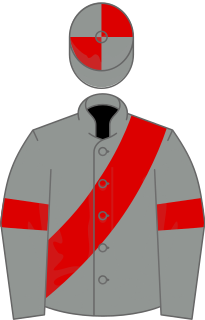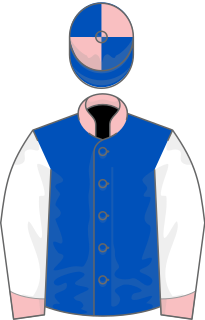Related Research Articles

Urban Sea was an American bred Thoroughbred racemare best known for winning France's most prestigious race in 1993 and for her importance as a world-class broodmare. She is one of ten mares to produce two Epsom Derby winners, namely Galileo and Sea the Stars. She is the only mare in the 21st century to produce two Epsom Derby winners. None has produced three winners of this race.
Noblesse (1960–1972) was an Irish Thoroughbred racehorse and broodmare.
Youth was an American-bred French Thoroughbred racehorse.
Gertrude T. Widener was an American socialite and a successful Thoroughbred racehorse owner and breeder. Born in Albany, New York, she was the daughter of Curtis N. Douglas, a businessman and New York State Senator.
Never Too Late was an American-bred, French-trained Thoroughbred racehorse. In a racing career lasting from August 1959 until October 1960, the filly ran nine times and won four races. As a two-year-old she proved herself capable of competing against the leading French colts by winning the Prix de la Salamandre at Longchamp and being narrowly beaten in the Grand Critérium. In the following year she was sent to Britain where she won the 1000 Guineas at Newmarket and Oaks at Epsom. She was then retired to stud at the end of her three-year-old season, and had some success as a broodmare.
Shadayid was an American-bred, British-trained Thoroughbred racehorse and broodmare. In a racing career which lasted from June 1990 to November 1991 she ran eleven times winning five races and being placed five times. Shadayid was one of the leading two-year-old fillies in Europe in 1990, winning all three of her races including the Group One Prix Marcel Boussac at the Longchamp. After winning the Fred Darling Stakes on her three-year-old debut, Shadayid took her unbeaten run to five by winning the Classic 1000 Guineas at Newmarket. Although she never won again, she finished second in the Coronation Stakes and the Sussex Stakes and third in the Haydock Sprint Cup and the Queen Elizabeth II Stakes. Shadayid was retired from racing to become a broodmare at the end of her three-year-old season after finishing seventh in the Breeders' Cup Mile.

Salsabil was an Irish-bred, British-trained Thoroughbred racehorse and broodmare. In a racing career which lasted from September 1989 to October 1990 she ran nine times and won seven races. Salsabil was one of the leading two-year-old fillies in Europe in 1989, winning two races including the Group One Prix Marcel Boussac at the Longchamp. After winning the Fred Darling Stakes on her three-year-old debut, Salsabil won both of Britain's Classic races for fillies: the 1000 Guineas over one mile at Newmarket and the Oaks over one and a half miles at Epsom. She was then raced against colts and became the first filly for ninety years to win the Irish Derby at the Curragh. In autumn, Salsabil added a victory in the Prix Vermeille at Longchamp but finished unplaced when favourite for the Prix de l'Arc de Triomphe in October. Salsabil was then retired to stud where she had success as a broodmare before dying of cancer in 1996.
Musidora was an Irish-bred British-trained Thoroughbred racehorse and broodmare, best known for winning two Classics in 1949. The filly won four times from twelve races in a racing career which lasted from 1948 until September 1949. After winning once as a two-year-old she won her first three races as a three-year-old including the 1000 Guineas over one mile at Newmarket and at The Oaks over one and a half miles at Epsom Downs Racecourse a month later. In the latter race she narrowly defeated the French filly Coronation, who went on to win the Prix de l'Arc de Triomphe. She finished unplaced in her three subsequent races and was retired to stud, where she had limited success as a broodmare.

Midway Lady was an American-bred, British-trained Thoroughbred racehorse and broodmare who won two British Classic Races in 1986. In a racing career lasting from August 1985 until June 1986, the filly ran six times and won her last five races. She sustained her only defeat when finishing second on her racecourse debut but won her remaining three races in 1985 including the May Hill Stakes at Doncaster and the Prix Marcel Boussac at Longchamp. Her three-year-old campaign consisted of only two races, as she won the 1000 Guineas at Newmarket and the Oaks at Epsom a month later. After sustaining a serious leg injury, she was retired to stud where she became a successful producer of winners including the Oaks winner Eswarah.
Musical Bliss (1986–2006) was an American-bred, British-trained Thoroughbred racehorse and broodmare who won the classic 1000 Guineas in 1989. In a racing career lasting from July 1988 until August 1989, the filly ran five times and won three races. In 1988, Musical Bliss won both her races including the Rockfel Stakes at Newmarket Racecourse. On her first appearance as a three-year-old, she won the 1000 Guineas but ran poorly in her two other races and was retired from racing at the end of the year. Her record as a broodmare was mixed.
Comtesse de Loir was a French Thoroughbred racehorse and broodmare. In her three-year racing career, she won only one important race, the Prix Saint-Alary in 1974. but was placed in numerous major events including the Critérium des Pouliches, Prix de Diane, Prix Vermeille, Prix de l'Arc de Triomphe (twice), Prix Ganay, Canadian International Stakes and Washington, D.C. International. Her performance in the 1973 Arc, when she was beaten a head by Allez France, saw her rated the best three-year-old of either sex to race in Europe that year.
Olwyn was a British Thoroughbred racehorse and broodmare best known for her win in the 1977 Irish Oaks. A daughter of The Derby winner Relko she won once from twelve races in 1976 and 1977. She finished no better than third in four starts as a two-year-old, but showed promising form in the spring of 1977, finishing second in the Pretty Polly Stakes and the Lancashire Oaks. After failing to win in her first nine races she recorded her first and only victory when narrowly winning a poorly contested Irish Oaks in July 1977. She was well beaten in two subsequent races and retired at the end of the year. She made little impression as a broodmare.
Immortal Verse is an Irish-bred, French-trained Thoroughbred racehorse and broodmare. As a two-year-old she showed promise by winning on her debut and finishing second in the Prix d'Aumale. Her early form in 2011 was disappointing as she was beaten in her first two races and refused to enter the starting stalls in the 1000 Guineas. She then made rapid improvement, winning the Prix de Sandringham and the Coronation Stakes at Royal Ascot before defeating a strong international field in the Prix Jacques Le Marois. She went on to finish third to Frankel in the Queen Elizabeth II Stakes but failed to reproduce her best form in two races as a four-year-old. After her retirement from racing she was sold at auction for 4.7 million guineas setting a European record price for a broodmare.
Pass the Peace was an Irish-bred, British-trained Thoroughbred racehorse and broodmare. She was one of the best two-year-old fillies of her generation in Britain and Ireland in 1988, when she won four races including the Debutante Stakes and the Cheveley Park Stakes. After winning the Fred Darling Stakes on her three-year-old debut she failed to win again, although she was placed in both the Poule d'Essai des Pouliches and the Sun Chariot Stakes. She later became a successful broodmare.
Matiya was an Irish-bred, British-trained Thoroughbred racehorse and broodmare. After winning on her racecourse debut she was beaten in her three remaining races as a two-year-old but showed very promising form when finishing third in the Fillies' Mile. In the following spring she finished second in the 1000 Guineas before recording her biggest success in the Irish 1,000 Guineas. She went on to finish third in the Prix de Diane but finished last in her two subsequent races and was retired from racing at the end of the year. She had limited success as a broodmare.
La Lagune was a French-bred Thoroughbred racehorse and broodmare. She initially made an impression by winning the Prix de Condé in the autumn of 1965 and added to her reputation with an emphatic victory in the Prix Vanteaux in the following spring. She was then sent to England for the Epsom Oaks and justified her position as favourite, as she ran out a very easy five length winner. She was unable to win again but ran well in defeat against very strong opposition before being retired at the end of the season. She had little chance to prove herself as a broodmare as she produced only one foal.

Valoris was a French-bred, Irish-trained Thoroughbred racehorse and broodmare. After showing promising form without winning a race as a juvenile in 1965 she developed into a top-class performer the following spring when she recorded emphatic victories in the Irish 1000 Guineas and the Epsom Oaks. She was well beaten in two subsequent starts and was retired from racing at the end of the year. She later had considerable success as a broodmare.
Imprudence was a French Thoroughbred racehorse and broodmare. She showed very promising form as a two-year-old in 1949 when she won two races and finished second in the Prix de la Salamandre. She reached her peak in the first half of the following year when she won the Poule d'Essai des Pouliches and the 1000 Guineas before recording an emphatic victory in the Epsom Oaks. She made little impact when competing in the United States as a four-year-old. She had some success as a broodmare.
Mesa (1932–1941) was a French Thoroughbred racehorse and broodmare. She showed very good form as a juvenile when she won two races and finished third in the Grand Critérium. In the following year she was sent to England where she won the 1000 Guineas and looked unlucky when finishing third in Epsom Oaks. She also finished second in the Prix du Président de la République and the Prix de La Jonchere and ran fifth in the Grand Prix de Paris. She made a very promising start to her time as a broodmare before dying at the age of nine.
Valentine Waltz was an Irish-bred Thoroughbred racehorse and broodmare. As a two-year-old she was initially trained in Ireland where she failed to win in four races although she did finish third in the Marble Hill Stakes. Later in the year she was moved to England and improved, winning a minor race and being placed in both the Rockingham Stakes and the Rockfel Stakes. In the following year she developed into one of the best fillies of her generation in Europe, winning the Nell Gwyn Stakes and the Poule d'Essai des Pouliches as well as finishing third in both the 1000 Guineas and the Coronation Stakes. After her retirement from racing she became a broodmare and had modest success as a dam of winners.